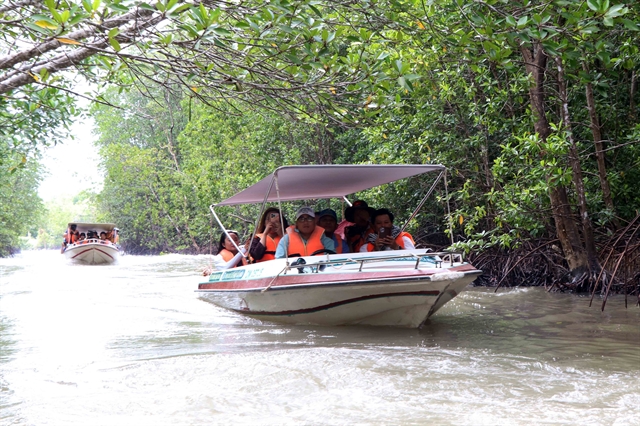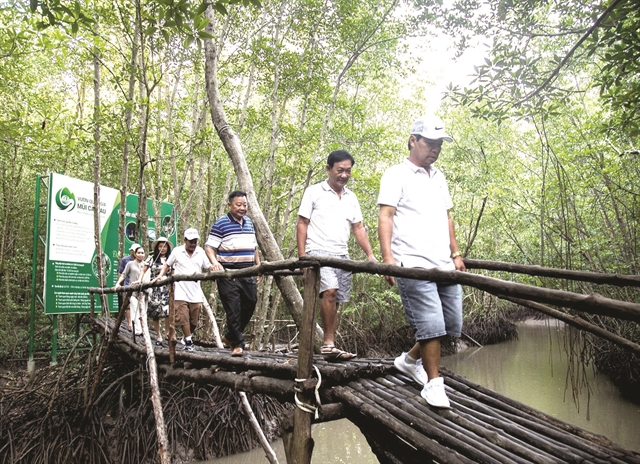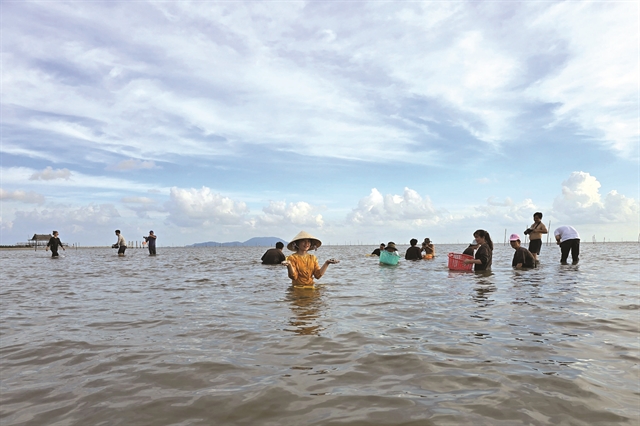Weather:
- Ha Noi 22oC
- Da Nang 22oC
- Ho Chi Minh 29oC

The southernmost province of Cà Mau is developing community-based ecotourism as a key tourism product to lure visitors and promote the industry.
Trần Hiếu Hùng, director of the Cà Mau Department of Culture, Sports and Tourism, says community-based ecotourism provides interesting experiences for tourists to explore the diverse nature and culture of the province.
He adds that the province will attract investors with ecotourism products, offering visitors an opportunity to escape busy urban areas and enjoy fresh air and rustic cuisine to refresh themselves.
Having untouched landscapes and rich biodiversity, Cà Mau has a lot of potential and advantages for developing sustainable ecotourism.
Over 100km away from Cà Mau City, the Cape Cà Mau National Park, located between the districts of Ngọc Hiển and Năm Căn, has a system of rivers and canals interspersed with mangrove swamps and vast melaleuca forests.
The 41,000-hectare park was recognised as a UNESCO World Biosphere Reserve in 2009. It is also a Ramsar site, the fifth in Việt Nam and the second in the Mekong Delta.
The Ministry of Construction recently appraised a master plan for developing the park into a national tourism site by 2030.
The site will have a total area of 20,100ha and consist of functional zones such as a natural reserve, a cultural space, and an entertainment area with shopping malls, resorts, and restaurants.
The province emphasises that sustainable development is its top priority to protect the environment, natural landscape and the lives of local people.
Under the project, the park will become the province’s largest ecotourism centre and one of the most visited destinations in the Mekong Delta by 2025.
It targets to welcome more than 1 million visitors, including 6,000 foreigners by 2025, and 2 million visitors, including 22,000 international visitors by 2030.
Hùng says the park brings not only economic benefits but also a clean environment to the province, as well as creating favourable conditions for ecotourism, sightseeing, relaxation and scientific research.
Nguyễn Đức Trung, deputy director of the Cà Mau Tourism Promotion Centre, says to develop sustainable and green community-based ecotourism, local authorities, tourism businesses including homestays should focus on unique products and experiences highlighting the beauty of the landscape and its cultural traits.
Cà Mau is introducing diversified tourism products such as a tour crossing Cape Cà Mau National Park to explore the biodiversity of the mangrove swamps and the lives of local residents.

The tour to U Minh Hạ National Park also provides interesting activities to tourists such as a trip through melaleuca forests, fishing, and gác kèo ong (literally, luring honey bees to build hives on sloping wooden poles), a unique craft recognised as a national intangible cultural heritage in 2020.
Located about 25km away from Cà Mau City, the 8,000-ha national park in U Minh and Trần Văn Thời districts has diverse varieties of flora and fauna typical of a seasonal wetland.
Lê Văn Quế from the northern province of Nam Định, who visited Cape Cà Mau for the first time, says he was impressed at the mangrove swamps and charming scenery of the land.
The 79-year-old man took a picture at the national coordinate marker at GPS number 0001 – the southernmost point on the mainland of Việt Nam, and took a motorboat across the mangrove swamps to admire the land and nature.
Trần Văn Hướng, an owner of a homestay in Đất Mũi Commune of Ngọc Hiển District, says: “The model of community-based ecotourism development associated with forest protection has brought many benefits to my family and households in the neighbourhood.”
"Visitors’ favourite activities in Cà Mau are exploring mangrove swamps, catching fish, clams and shrimps, and enjoying local dishes such as fermented hot pot with seafood and wild vegetables and sweet and sour soup with grey eel-catfish," he says.
Hướng says he hopes that local authorities will invest in transport infrastructure in waterways and roads to create convenience for tourists, and offer skills training and share knowledge and experiences with local tourism workers.
Tourism department director Hùng says: "The province has issued priority policies for tourism development to attract investors in infrastructure and tourist areas and destinations, and promote Cà Mau’s images to domestic and international tourists."
New destinations

Under the province’s master plan for tourism development by 2030, Cà Mau will focus on developing and calling on investment in ecotourism zones of Thị Tường Lagoon in the three districts of Cái Nước, Trần Văn Thời and Phú Tân, the Trẹm River in U Minh District, and the Khoai Islands in Ngọc Hiển District.
Thị Tường Lagoon, 27km from Cà Mau City, is the largest natural lagoon in the Mekong Delta.
It has a total water surface area of more than 700ha and is home to diverse kinds of fish, cockle, shrimp, and crab.
The lagoon is also known for its beautiful nature, where visitors can enjoy a peaceful environment and experience local people’s daily activities.
Visitors should not miss the Xéo Đước Provincial Party Committee Base when visiting the lagoon. The site was the headquarters of the revolutionary campaign in the countryside of Cà Mau between 1960 and 1975 against the Sài Gòn regime, and was recognised as a provincial historical relic site in 2007.
Meanwhile, the Trẹm River ecotourism zone has a total area of 110ha, with forest ecosystems of more than 300 species of plants and animals.
The Khoai Islands, surrounded by green forests, mountains and beautiful beaches, is an attractive destination for visitors to Cà Mau. It is also known for its extremely rich flora with more than 1,400 species, ranging from century-old trees to fruit trees.
"The province and tourism businesses have done their best to promote community-based ecotourism," Director Hùng says.
“The province expects to have support from tourism experts and investors to develop new tourist activities, homestays and tourist areas to attract more visitors.”
According to the department, Cà Mau has 34 community-based tourism areas and homestays, including two provincial sites.
The province targets to welcome more than 2.35 million visitors in 2024, and to have a total tourism revenue of VNĐ3.48 trillion (US$137 million).
The number of arrivals in the first ten months of this year was more than 1.7 million.
Total tourism revenue reached more than VNĐ2.55 trillion ($100.4 million), up 6.16 per cent compared to the same period last year. VNS




